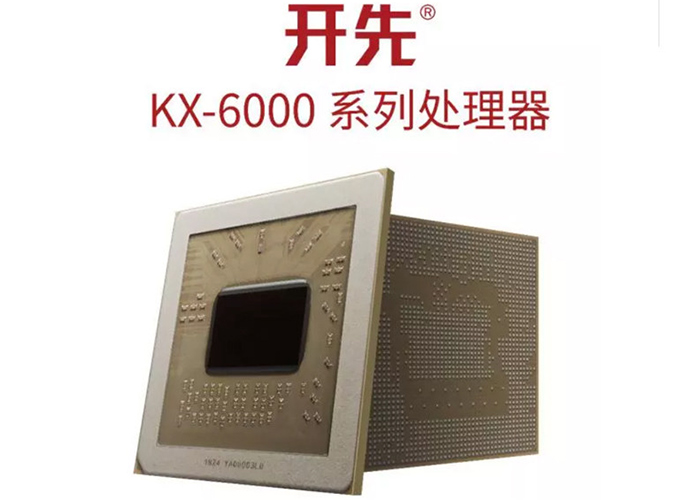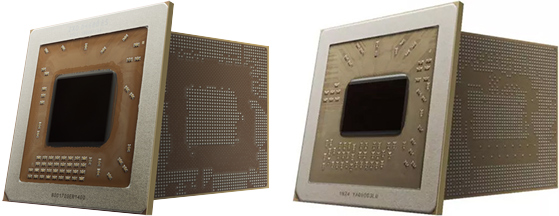Zhaoxin Displays x86-Compatible KaiXian KX-6000: 8 Cores, 3 GHz, 16 nm FinFET
by Anton Shilov on September 24, 2018 12:00 PM EST
Zhaoxin, a joint venture between Via Technologies and the Chinese government, this week for the first time displayed its upcoming x86-compatible CPU, the KaiXian KX-6000. The SoC features eight cores running at 3 GHz and increases performance over its predecessor by at least 50%.
The KaiXian KX-6000 is a successor to the KX-5000 CPU launched earlier this year. Both chips integrate eight-core x86-64 cores with 8 MB of L2 cache, a DirectX 11.1-capable iGPU with an up-to-date display controller, a dual-channel DDR4-3200 memory controller, contemporary I/O interfaces (PCIe, SATA, USB, etc), and so on. The key differences between the KaiXian KX-5000 and the KaiXian KX-6000 are frequencies and manufacturing technology: the former is produced using TSMC’s 28 nm fabrication process and runs at up to 2 GHz, whereas the latter is made using TSMC’s 16 nm technology and operates at up to 3 GHz. Zhaoxin claims that the Kaixian KX-6000 offers compute performance comparable to that of Intel’s 7th Generation Core i5 processor, which is a quad-core non-Hyper-Threaded CPU. Obviously, performance claims like that have to be verified, yet a 50% performance bump over the direct predecessor already seems beefy enough.
As the picture below shows, the thinner manufacturing process enabled Zhaoxin to make the KaiXian KX-6000 die smaller when compared to the predecessor, which will eventually shrink its manufacturing cost. Meanwhile, the two processors use different HFCBGA packaging and therefore cannot use the same motherboards. Meanwhile it is unknown whether the new KaiXian KX-6000 is compatible with Zhaoxin’s USB 3.1 Gen 2-capable ZX-200 chipset.
The Zhaoxin KaiXian KX-6000 relies on the LuJiaZui microarchitecture, which is an evolution of the WuDaoKou microarchitecture that powers the KX-5000 processor introduced in early 2018. Based on what we know today, the LuJiaZui is an x86-64-compatible superscalar, multi-issue, out-of-order microarchitecture that supports contemporary instruction sets extensions like SSE 4.2 and AVX along with virtualization and encryption technologies. Zhaoxin has yet to disclose differences between its LuJiaZui and WuDaoKou designs. Therefore, all we can do is speculate that since the microarchitectures are launched within one year from each other they are very similar, but the newer one has minor optimizations that, perhaps, enable higher clocks, improved caching, better memory support, etc.
Zhaoxin has not announced when it plans to start commercial shipments of its KaiXian KX-6000 processors, as right now it only displays its picture (which proves that it exists). Based on the previously published roadmap, we'd expect the CPU to hit the market in 2019, though when exactly is anyone's guess.
| Zhaoxin's Kaixian KX-5000 and KX-6000 CPUs | |||
| Kaixian KX-5000 WuDaoKou |
Kaixian KX-6000 LuJiaZui |
||
| Core Count | 4 - 8 | Up to 8 | |
| L2 Cache | 8 MB | 8 MB | |
| Frequency | Up to 2 GHz | Up to 3 GHz | |
| ISA | x86-64 | ||
| ISA Extensions | SSE 4.2, AVX | ? | |
| APIC | Yes | ||
| Virtualization | VMX technology, compatible with Intel's VT-X | ||
| Temperature monitoring, overheat protection | Yes | ||
| Power States | C1, C2, C3, C4, P-State | ? | |
| Hardware Encryption Engines | Advanced encryption engine (ACE), SHA-1, SHA-256, SM3/SM4, Randomizer | ? | |
| Security | TXT, EDB | ? | |
| iGPU | DirectX 11.1 feature set. Hardware-accelerated video encoding/decoding. Outputs: DP, eDP, HDMI, D-Sub Max Resolution: 4K Number of Displays: 3 |
? | |
| Packaging | x-ball HFCBGA 37.5 x 37.5 mm |
y-ball HFCBGA 37.5 x 37.5 mm |
|
| Process Technology | TSMC 28 nm | TSMC 16 nm FinFET | |
Related Reading:
- Cypress and Zhaoxin Have USB 3.1 Gen 2 USB Controllers
- China Calling: AMD Forms Joint Venture for x86 Server SoCs in China
- AMD Creates Quad Core Zen SoC with 24 Vega CUs for Chinese Consoles
Source: PC Watch











77 Comments
View All Comments
Teckk - Monday, September 24, 2018 - link
Interesting. Maybe this or the next gen will take some share from Intel/AMD in China market.Isn't AMD also working on a JV such as this, but on the server side?
FirstStrike - Monday, September 24, 2018 - link
No they won't. This chip is born for government purchasing. No consumer or enterprise will be foolish enough to use anything other than Core/Zen.But if you count government orders as part of market share, then, yes.
Death666Angel - Monday, September 24, 2018 - link
"But if you count government orders as part of market share, then, yes." Aren't they counted usually? Seems to me any customer should be counted.Strunf - Tuesday, September 25, 2018 - link
Buying from yourself doesn't really count as buying!Death666Angel - Tuesday, September 25, 2018 - link
First of all, this is a JV, not wholly owned by the Chinese gov't. Secondly, if there are 10^9 x86 computers out there and 20% are run by AMD chips, 75% are run by Intel chips and 5% are run by "others", who cares if 2% of the Intel chips are inside computers used by Intel engineers/marketing/HR etc.? Since when is that taken into account?rahvin - Tuesday, September 25, 2018 - link
>>First of all, this is a JV, not wholly owned by the Chinese gov't.I'd like to see you prove that. In the best of cases Chinese financial transactions are black box, ventures like this are almost entirely funded with unsecured government backed loans with companies headed by high level party officials, members of the Army or intelligence apparatus.
China is not a free market, and people that assume it is simply don't understand how things work over there.
close - Tuesday, September 25, 2018 - link
"Zhaoxin, a joint venture between Via Technologies and the Chinese government".I'd like to see you prove that it isn't. I mean I have no idea but you know, burden of proof and all that. Officially it's a JV until someone can prove the contrary.
levizx - Monday, October 1, 2018 - link
and you are such an expert because? I at least lived there for 20+ year.levizx - Monday, October 1, 2018 - link
Prove what? You simply don't understand how capital works. Free market or not, it doesn't affect how ownership works. Your assumption is simply not true, and quite ridiculous.Mr Perfect - Tuesday, September 25, 2018 - link
You forget that all Chinese consumers and businesses are government, comrade.In all seriousness, if China is concerned that Intel/AMD hardware could be used by other nations to spy on them, they'll push for Chinese made hardware in any market segment they want to protect. And you don't say no to those requests.